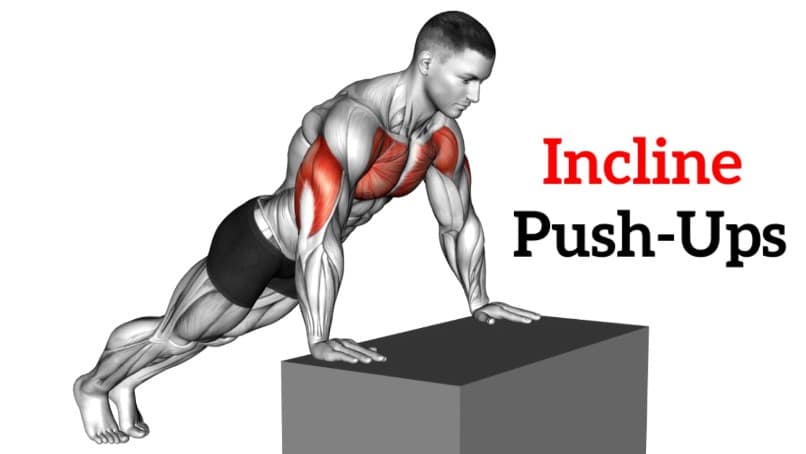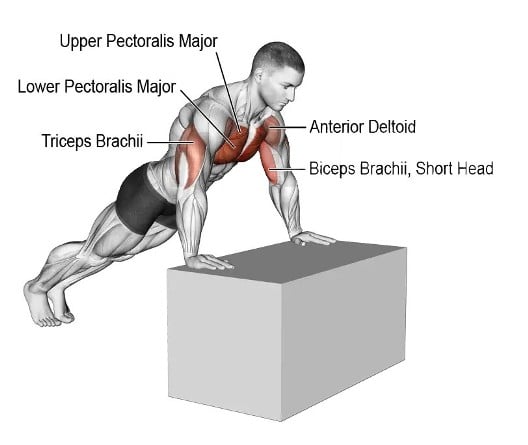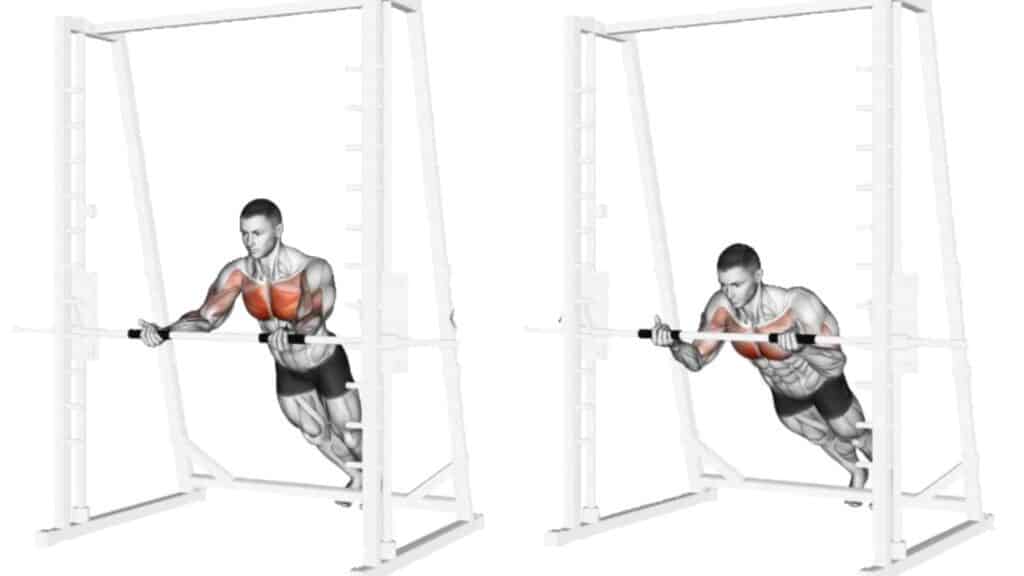Push-ups are a great way to strengthen your chest muscles and also train your shoulder and triceps. If you have trouble doing the basic push up, incline pushups are a good way to start.
The incline position reduces the amount of bodyweight you have to lift and puts less stress on your elbows. It’s perfect for beginners and pros who want to build upper body strength.
Adding incline push-ups to your bodyweight workout routine can help build additional strength and muscle mass.
In this blog, we will talk about what incline push ups are, the muscles that are used during them, how to do them correctly, and how to include them in your workout routine.

- What is Incline Push Up
- Make It Easier Or Harder (Regression & Progression)
- Incline Push Up Muscles Worked
- How To Do Incline Push-Up On Box
- Form and Tips To Do Incline Pushups
- Incline Push-Ups Modifications and Variations
- 1. Incline Wall Push Up
- 2. Incline Push-Up On Brick
- 3. Stability Ball Push Up
- 4. Reverse Grip Incline Push Up
- 5. Medicine Ball Push-Up
- Takeaways
- People Also Asked
- Do Incline Push Ups Work Lower Chest
- What Are Incline Push-Ups?
- When to Perform The Incline Push Up
- Are Incline Push ups easier
- Are Incline Push Ups good
- What do incline push ups work
- How many incline push-ups should I do
- Which type of pushups should you do?
- Are incline push-ups easier than decline?
- References
What is Incline Push Up
The classic push-up has survived the test of time and is the single most efficient exercise to simultaneously strengthen the chest, arms, deltoid, lower back, abs and glutes. It is a compound exercise that involves raising and lowering the body using the arms while facing down in a horizontal position.
Incline push-ups are easier than normal push-ups because they have to be done at an incline angle. The push will be 50% easier if you have a 45-degree incline angle with your feet below your head, than if you have a horizontal angle.
The incline surface means that more of the lower chest, shoulder muscles, and triceps are used in incline push-ups.
If a standard push up is too hard or you have trouble getting down to the floor, Incline pushups are the perfect compromise. The push up is easier if you are upright.
The Incline push-up is one of the greatest conditioning exercises for the outdoor athlete, it can be performed, regardless of where you are and, best of all, they are completely free—no expensive equipment or no annual gym fees required. All you need is a stable surface such as a table, desk, or wall.
Make It Easier Or Harder (Regression & Progression)
If you want to make incline pushups easier, place your hands on a wall or more inclined surface. Just about anyone can do this beginner version because you’re not lifting a large percentage of your bodyweight, and it doesn’t require as much flexibility.
To make incline pushups harder, you can use any of the variations listed below, which reduce the angle of inclination or use a stability ball.
Once you’ve mastered the incline push-up, then you may want to try standard pushups and decline push-ups.
Incline Push Up Muscles Worked
The muscles that are worked and with greater or lesser intensity, will depend on the degree to which you perform incline push up exercise. The main muscles involved in push-ups are:
- Primarily muscles during incline push ups are Lower Chest, Anterior deltoids (shoulder muscle), and triceps.
- Secondary muscles during pushups are the upper chest, lateral deltoid, serratus, trapezius, and core muscles (abs, lumbar, gluteal, pelvic, and deep spinal muscles).

How To Do Incline Push-Up On Box
The incline box push up is a great bodyweight exercise that you can do to build your chest. It offers numerous benefits and is perfectly suited for both beginners and experienced athletes looking to build upper body strength.
You can do this with a chair, a gym bench, a sofa, a box, a sturdy table, or anything else.

- Stand approximately 3 to 3.5 feet away from a low bench or sturdy chair. Ensure the box is sturdy and won’t slide.
- Place your hands on the box shoulder-width apart, with your fingers pointing forward.
- Your palms should be flat, with fingers pointing forward or slightly turned inwards.
- Slowly lower yourself by flexing your elbows so that your chest comes within a few inches of the edge of the chair or bench.
- Keep your elbows at about a 45-degree angle to your torso. Your chest should be directed towards the box and not your face.
- Push yourself back to the starting position while keeping your body straight from head to ankle.
- Aim for 3-4 sets of 10-15 reps.
Form and Tips To Do Incline Pushups
Follow the proper foam and techniques to get the most out of this move.
- For the incline push-ups, begin by performing 2–3 sets of 6–8 repetitions. Add more reps and sets as you build strength.
- Choose the exercises as per your fitness levels. And also choice your sets and repetitions based on your ability to maintain good technique throughout all sets and repetitions.
- Pay extra attention to your form and emphasize quality over quantity to improve your upper-body strength.
- Do not let your lower back sag or your butt rise. Ensure your body is straight and rigid.
- Slow down all of your movements and really stay focused on your form.
- The core and glutes should be contracted during the exercise.
- Your neck should be in line with your body, not tilted up, which could strain the neck.
- If you are having trouble perfecting your form for this incline push up, it can be helpful to break down the movement, regress, and work on the foundation.
- To see continual progress and build body strength, incorporate proper warm-ups, rest, and nutrition into your exercise program.
- Rest for 24 to 48 hours before training the same muscle groups to allow sufficient recovery.
Incline Push-Ups Modifications and Variations
The incline push up can be changed by changing the height of the object you are pushing up from. If you want to make incline pushups easier, place your hands on a wall or more inclined surface.
When you can do 15-20 basic incline pushups in a row, or you may want to increase the intensity of push-ups, then reduce the bench height. Or try doing the incline push up on a less stable surface such as a stability ball push up, or medicine ball push up.
1. Incline Wall Push Up
The incline wall push-up is a simple type of push-ups that dramatically reduces the pressure on the arms, upper back, and abs.
The closer you stand to the wall, the easier it is to perform, but remember, it’s still important to be aware of your body alignment as you perform this push-up.

How To Do Wall Push-Ups
- Stand approximately 2 to 2.5 feet away from the wall with your arms held at shoulder height in front of you.
- Place your hands against the wall with your body straight and your legs a few feet behind, so that your body draws a triangle together with the wall and the floor.
- Keeping your feet firmly fixed to the ground, lean your body forward so that your elbows flex and your chest comes within inches of the wall.
- Using your hands, push your body back into a standing position.
2. Incline Push-Up On Brick
The higher you are, the easier the push-up, while the lower you are, the more challenging it is. Incline brick push-ups move will work the chest, deltoids, and triceps, and the slight incline will put more work on the lower chest than standard push-ups.
Push ups can be performed with a multitude of variations to bring about different muscular recruitment patterns. Performing push-ups at an incline angle will put more focus on the lower chest.

How To Do Brick Push-Ups
- Put the hands, shoulder-width apart, on the bricks.
- Adopt an incline plank position by extending the legs backward until the legs and back form a straight line.
- Slowly bend the arms to lower the chest toward the bench. Remember to keep the elbows and arms close to the body.
- Slowly push the body away from the bench, extending the arms but maintaining a slight bend in the elbow.
- Perform 8–12 reps for one set.
3. Stability Ball Push Up
Using a stability ball can make push-ups more difficult by giving you an uneven surface to work with. This is a great exercise for working the lower part of the chest.
You will have to work harder to maintain your balance on the ball, which will make the move more challenging than the standard, floor-based version.

How To Do Stability Ball Push Up
- Lay with your chest on the stability ball. Place your hands on the ball at the sides of your chest. They will be shoulder-width apart.
- Place feet back and lean forward so that your chest is directly over the ball, and you are supported on your toes.
- Push your body up, until your arms are almost straight (do not lock your elbows). Pause here for a second.
- Breathe out and extend your arms to bring your upper body back to the starting position.
- Repeat for the desired number of repetitions.
4. Reverse Grip Incline Push Up
The reverse grip incline push up is a variation of the push up that is used to target the chest muscles. It works the shoulder and triceps muscles as well. It is a bodyweight exercise performed on a smith machine or other elevated surface.
Reverse push up uses a reverse grip to change the point of emphasis to the mid-chest.

How To Do Reverse Grip Incline Push Up
- Stand approximately 3 to 3.5 feet away from a bench and smith machine.
- Reach forward and grab the bench or smith machine bar with a reverse grip.
- Slowly descend to the bench or bar by retracting the shoulder blades and unlocking the elbows.
- Descend until your chest touches the bench or bar.
- Push back to the starting point by extending the elbows and driving your palms into the bench.
- Repeat for the desired number of reps.
5. Medicine Ball Push-Up
The medicine ball push-up is a strength exercise that works the chest and shoulders, with a little more focus on the triceps. The instability of the ball improves core strength and stability.
Doing push-ups with your knees bent on the floor or placing a medicine ball on a higher platform can both reduce resistance. You can substitute a brick for a medicine ball.

Takeaways
Incline push-ups are a useful chest exercise to incorporate into your strength-training program.
It activate multiple muscle groups throughout your upper body, including your anterior deltoids, pectoralis major, and triceps.
With the ability to adjust your incline to any height that works for you, you can work on your strength and form, and soon enough, you’ll be making serious push up progress.
People Also Asked
Do Incline Push Ups Work Lower Chest
The incline push up is one of the best pushups for the lower chest. You will be expected to incline at a certain angle in order to complete this move. The inclination is what helps target the lower chest muscles.
What Are Incline Push-Ups?
Incline push-ups are a bodyweight exercise that puts special emphasis on the muscles in your lower chest. Perform the incline push-up with your hands on a bench or other elevated surface. It is a variation of the standard push-ups that reduces the amount of body weight you are lifting and allows you to practice with less strain on your arms and shoulders.
When to Perform The Incline Push Up
These Incline push ups are a must-have for any chest-focused workout. You should do them at the end of the workout because of their simplicity and lower resistance. Also do the other push ups variation to build upper body mass and strength.
- Standard push ups
- Decline push ups
- Close-grip push up
- Pike Ups
- Hindu push ups
Are Incline Push ups easier
Incline push-ups are easier than compared to the normal push-ups ones because of the angle at which the exercise has to be done. If you want to make incline pushups easier, place your hands on a wall or more inclined surface.
Are Incline Push Ups good
Incline pushups are a good push-up variation that takes some of the pressure off of your arms and shoulders to give you a good chest workout.
What do incline push ups work
The incline position primarily works your lower chest muscles, but you’ll also need to engage your upper chest, shoulder, tricep and core muscles.
How many incline push-ups should I do
For incline push-ups, begin by performing 3–4 sets of 10–20 repetitions, focusing on maintaining good technique.
Which type of pushups should you do?
For a more well-rounded physique, you might consider using various push ups.
- Standard push ups are best for chest, shoulder and tricep.
- Incline Push Up works your lower chest more.
- On the other hand, the decline push-up works the upper chest and front shoulders more than the regular or incline variation.
- Close grip push-ups focus more on the tricep than the chest.
- Pike Push-ups focus more on shoulder than chest and tricep.
Are incline push-ups easier than decline?
Incline pushups are easier than regular or decline pushups. Due to the incline position, it reduces the amount of bodyweight you are lifting and puts less stress on your elbows.
It is a great way to build your chest, shoulder, and tricep, and is perfect for beginners and pros.
References
- Cogley RM, Archambault TA, Fibeger JF, Koverman MM. Comparison of muscle activation using various hand positions during the push-up exercise. Journal of strength and conditioning research. 2005 Aug 1;19(3):628.
- Freeman S, Karpowicz A, Gray J, et al. Quantifying muscle patterns and spine load during various forms of the push-up. Med Sci Sports Exerc 2006; 38: 570–577.
- Cogley R.M., Archambault T.A., Fibeger J.F., Koverman M.M., Youdas J.W., Hollman J.H. (2005) Comparison of muscle activation using various hand positions during the push-up exercise. Journal of Strength & Conditioning Research 19, 628-633.
- Borreani S, Calatayud J, Colado JC, et al. Muscle activation during push-ups performed under stable and unstable conditions. J Exerc Sci Fit 2015; 13: 94–98.
- Ebben WP, Wurm B, Vanderzanden TL, et al. Kinetic analysis of several variations of push-ups. J Strength Cond Res 2011; 25: 2891–2894.

Manish brings over 10 years of hands-on experience in weight lifting and fat loss to fitness coaching. He specializes in gym-based training and has a lot of knowledge about exercise, lifting technique, biomechanics, and more.
Through “Fit Life Regime,” he generously shares the insights he’s gained over a decade in the field. His goal is to equip others with the knowledge to start their own fitness journey.
